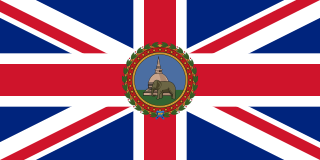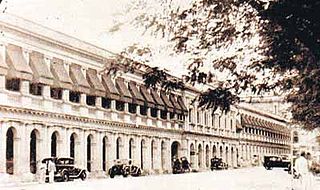
The Parliament of the Democratic Socialist Republic of Sri Lanka is the supreme legislative body of Sri Lanka. It alone possesses legislative supremacy and thereby ultimate power over all other political bodies in the island. It is modeled after the British Parliament.

The State Council of Ceylon was the unicameral legislature for Ceylon, established in 1931 by the Donoughmore Constitution. The State Council gave universal adult franchise to the people of the colony for the first time. It replaced the Legislative Council of Ceylon, the colony's original legislative body.

The Constitution of the Democratic Socialist Republic of Sri Lanka has been the constitution of the island nation of Sri Lanka since its original promulgation by the National State Assembly on 7 September 1978. As of October 2022 it has been formally amended 21 times.

The governor of Ceylon was the representative in Ceylon of the British Crown from 1795 to 1948. In this capacity, the governor was president of the Executive Council and Commander-in-Chief of the British Forces in Ceylon. The governor was the head of the British colonial administration in Ceylon, reporting to the Colonial Office.

Patrick de Silva Kularatne was a Sri Lankan educationist and politician. He was a Member of the State Council of Ceylon (1942-1947) and Member of Parliament (1960-1965). He served as Principal of Ananda College and Dharmaraja College and established Nalanda College Colombo, Ananda Balika Vidyalaya, Moratuwa Vidyalaya and Dharmapala Vidyalaya. As a member of the executive committee on Education, he played an instrumental role in the realisation of free education from kindergarten to university.

Dr. Cristopher William Wijekoon Kannangara was a Sri Lankan Lawyer and a politician. He rose up the ranks of Sri Lanka's movement for independence in the early part of the 20th century. As a lawyer he defended the detainees that were imprisoned during the Riots of 1915, many of whom were the emerging leaders of the independence movement. In 1931, he became the President of Ceylon National Congress, the forerunner to the United National Party. Later, he became the first Minister of Education in the State Council of Ceylon, and was instrumental in introducing extensive reforms to the country's education system that opened up education to children from all levels of society.
The Ceylon Civil Service, popularly known by its acronym CCS, was the premier civil service of the Government of Ceylon under British colonial rule and in the immediate post-independence period. Established in 1833, it functioned as part of the executive administration of the country to various degrees until Ceylon gained self-rule in 1948. Until it was abolished on 1 May 1963 it functioned as the permanent bureaucracy or secretariat of Crown employees that assisted the Government of Ceylon.
In Sri Lanka, the Cabinet of Ministers is the council of ministers that form the central government of Sri Lanka. The body of senior ministers responsible and answerable to the Parliament of Sri Lanka. The President is a member of the cabinet and its head.

The Legislative Council of Ceylon was the legislative body of Ceylon established in 1833, along with the Executive Council of Ceylon, on the recommendations of the Colebrooke-Cameron Commission. It was the first form of representative government in the island. The 1931 Donoughmore Constitution replaced the Legislative Council with the State Council of Ceylon.
The Executive Council of Ceylon was the Executive Council created in Ceylon by the British colonial administration on the recommendations of the Colebrooke-Cameron Commission along with the Legislative Council of Ceylon in March 1833.
General Officer Commanding, Ceylon was the designation of the General Officer appointed to command all British Army units stationed in the island of Ceylon during the British colonial administration of the island. The post was succeeded by the Commander of the Ceylon Army.
The Colebrooke–Cameron Commission was appointed in 1833 as a Royal Commission of Eastern Inquiry by the British Colonial Office to assess the administration of the island of Ceylon and to make recommendations for administrative, financial, economic, and judicial reform. According to Sir Charles Jeffries' book, Ceylon - The Path to Independence, "by the time the Commission got round to Ceylon, in 1829, most of the members had fallen by the wayside, and only one, Major Colebrooke was left."

Wilmot Arthur de Silva was Ceylonese veterinary surgeon, politician and philanthropist. He was the Minister of Health (1936–1942) in the second State Council of Ceylon and a former President of the Ceylon National Congress.
The New Year Honours 1892 were appointments by Queen Victoria to various orders and honours of the United Kingdom and British India.
Evelyn Charles Arthur Villiers JP UPM was a British planter and politician in colonial Ceylon.
Howard Frank Parfitt was a British tea planter, businessman and politician in colonial Ceylon.
The Chief Secretary of Ceylon, was the Chairman and one of three officers of state of the Board of Ministers of the State Council of Ceylon from 1932 to 1947. The post succeeded that of Colonial Secretary which was one of six offices that held a seat in the Executive Council of Ceylon until 1932.
The Financial Secretary of Ceylon was an officer of the Ceylonese Government and member of the Board of Ministers. The Treasurer of Ceylon was one of six offices that held a seat in the Executive Council of Ceylon from 1809 to 1932. The post was replaced by the that of Financial Secretary in 1932, as one of three officers of state of the new Board of Ministers that replaced the Executive Council under recommendations of the Donoughmore Commission. The Financial Secretary was in turn replaced by the new office of the Minister of Finance in 1947 under the recommendations of the Soulbury Commission under the Ceylon Independence Act, 1947 and The Ceylon Orders in Council 1947.









